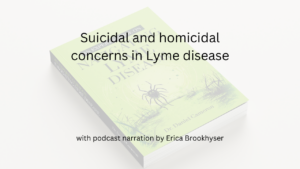Call for your appointment today 914-666-4665 | Mt. Kisco, New York

Hello, and welcome to another Inside Lyme Podcast. I am your host Dr. Daniel Cameron. In this episode, I’ll be discussing a case involving a man in his 70’s who had an abrupt onset of involuntary body movements, including jerks in his left arm. The man was initially dismissed as having a functional disorder, when in fact, his involuntary body movements was due to Lyme disease.
Li and colleagues described this case, entitled “Lyme neuroborreliosis presenting as spinal myoclonus” in the journal BMJ Case Rep.. [1]
While visiting the Czech Republic, the man developed a large round erythematous rash on his left arm. He also removed a tick from his thigh. Doctors prescribed amoxicillin and the rash resolved within 3 days.
Three weeks later, the man was evaluated at a clinic in Canada for radicular pain down his left arm. His symptoms progressed, which included involuntary body movements in multiple limbs. “Within 1 week, these jerks progressed to his contralateral arm and bilateral legs as well as the trunk, consistent with propriospinal myoclonus,” the authors explain.
Propriospinal Myoclonus (PSM) is an extremely uncommon movement disorder characterized by myoclonic jerks, writes Verma and colleagues,2 adding that “PSM has sometimes been dismissed as psychogenic in some cases.”
Multiple Emergency Room Visits
The man, who presented to multiple emergency rooms, was given Pregabalin to treat his pain. Doctors diagnosed the patient with a functional disorder.
During this third visit to the emergency room, the man was finally diagnosed with Lyme disease. Laboratory tests were positive for Lyme disease by IgM EIA and Lyme IgM Western blot.
He subsequently tested positive for Borrelia afzelli. His spinal tap revealed an elevated protein with a lymphocytic pleocytosis. His MRI showed abnormal patchy cauda equina nerve root enhancement and anterior spinal cord enhancement at C5–C6.
The patient was treated successfully for Lyme disease with 7 weeks of oral and intravenous antibiotics.
This is not the first case of propriospinal myoclonus. Propriospinal myoclonus was described in a 60-year-old woman following a tick bite and erythema migrans, the authors write. However, a spinal tap later revealed she was positive for Borrelia burgdorferi antibodies.
Editor’s note: This is a good example of a Lyme disease patient being dismissed as having a psychogenic or functional disorder instead of being recognized as involuntary body movements lyme disease. The authors published a photo of the rash which was clearly a typical erythema migrans (EM) rash. The initial 3-day course of antibiotics would not be expected to be effective in treating Lyme disease.
The following questions are addressed in this episode:
- What is radicular pain?
- Can involuntary body movements be a symptom of Lyme disease?
- The patient was treated briefly for the rash. Your thoughts?
- What is propriospinal myoclonus?
- This movement disorder is often dismissed as a psychogenic illness?
- What is the significance of a diagnosis of psychogenic illness?
- The patient wasn’t diagnosed with Lyme disease until his 3rd ED visit?
- How do you interpret the laboratory tests?
- What are your thoughts about this patient’s treatment?
-
- Thanks for listening to another Inside Lyme Podcast. You can read more about these cases in my show notes and on my website @DanielCameronMD.com. As always, it is your likes, comments, reviews, and shares that help spread the word about Lyme disease. Until next time on Inside Lyme.
Please remember that the advice given is general and not intended as specific advice as to any particular patient. If you require specific advice, then please seek that advice from an experienced professional.
Inside Lyme Podcast Series
This Inside Lyme case series will be discussed on my Facebook and made available on podcast and YouTube. As always, it is your likes, comments, and shares that help spread the word about this series and our work. If you can, please leave a review on iTunes or wherever else you get your podcasts.
References:
- Li X, Kirschner A, Metrie M, Loeb M. Lyme neuroborreliosis presenting as spinal myoclonus. BMJ Case Rep. Dec 29 2019;12(12)doi:10.1136/bcr-2019-233162
- Verma R, Praharaj HN, Raut TP, Rai D. Propriospinal myoclonus: is it always psychogenic? BMJ Case Rep. Jul 29 2013;2013doi:10.1136/bcr-2013-009559




My son had involuntary limb movements but not the pain. He also had nightmares and severe acute anxiety. 5 neurologists saw him and no one did an MRI or spinal tap. His neuro exams were all considered normal and we were told it was anxiety even though the attending ER psychiatrist at CHOP told us it was not anxiety causing the movements.He was eventually diagnosis with Lyme, Babesia, Bartonella and mycoplasma. It was 5 years to fully diagnosis and treat him. He missed a significant part of his childhood. Thank you for these podcasts and I hope physicians subscribe and educate themselves on the multiple presentations of tick borne disease.
It is a shame it took so long for your child to get an answer. Thank you for your support of the podcast.
Is your son well after treatment for lyme? He stil has involuntary limb movement? Please I’m desperate my son does does to and he has lyme, mycoplsma and bartonela. Please update, please
Hi Sharri ! Is your son ok? My son has involuntary limb movement from lyme disease. Please tel me what treatment is he taken. Thanks
I have had involuntary movement in my left hand for about 4 years also in my legs I did get tested for lyme in canada but it came back neg. I can not use my left hand at all the doctor gave me pills for parkinson which I do not think i have it all started when i was clearing brush from the side of my driveway when i was done I had a small hole in the top of my hand and it took 6 months for it to heal every time i try to the doctors what happened they do not listen to me I have tried telling 4 doctors what happened but because the lyme test came back neg. they are treating me for every thing else. This has been going on for 4 years. Some times they send back to the same doctor who said their is nothing he can do for me. I have seen a hand doctor and he sent me back to the same doctor who said their is nothing he can do for me” I do not know what else to do.
I wrote the blog to remind doctors to add Lyme disease to a movement disorder in the absence of another cause even if it unlikely.
My 6 year old son presented with myclonous movement disorder 10 days after an absess infection in his tooth that spread all the way up to his eyes. The tooth was pulled but he was put on only 5 days of antibiotics. His hands and feet jerk at nigh now. He grinds his teeth all night and has numbness and prickling in is hands and feet. The spasms don’t stop. Full body and facial tic. This is the second time this has happened after a dental treatment but the last time he responded to antibiotics given to him for an unrelated ear infection after which all is movements, teeth grinding and arching of his back, twitching disapeared. This time no Dr or two neuros I have done vitural appointments with will prescribe antibiotics because his lyme panel came back negiteve. They have no answers. No treatment. Even ER visit. Bloodwork and two eegs normal. I pulled a tick off his head years ago but they won’t believe it is lyme. I have no treatment for my son and his health is declining rapidly with this infection. Please, how can I help my son?
I have suggested patients in my practice to consider an evaluation for PANS and PANDAs. https://danielcameronmd.com/lyme-disease-pandas/
After the Lyme treatment, did the jerking stop? Quite an important omission!
Hi Sharri ! Is your son ok? My son has involuntary limb movement from lyme disease. Please tel me what treatment is he taken. Thanks
I’ll share this with my specialists–the neurologist and the physiatrist who prescribes the medication I must take to (mostly) quell the jerking. It started around 2004. I have no memory of a tick bite, but of course the bullseye rash is often absent.
Without hard-to-obtain medication, jerking starts in my legs and soon spreads to the rest of my body, which jerks 60 times a minute. It’s like a slow-motion seizure that never stops.
My diagnoses to date have been RLS and myoclonus. but they don’t quite fit.
Lynn,
What mediation did you find helpful? I was on IV antibiotics, which cleared my symptoms, but I stated twitching again within a week of going off the IV.
I have had involuntary movements of parts of my body and sometimes my entire body. Looking at me you would think I was having a seizure. I got a tick bite in August 2015, went to my primary doctor and he recognized that I had a bullseye rash and diagnosed Lyme disease. The jerking started about 3 months later. Neurologist diagnosed as myoclonus seizure and another neurologist diagnosed I had PTSD because of some trauma. He basically wouldn’t let me out of his office until I got an appointment with a psychologist. I never went.
I found a Lyme literate medical professional about six months later that has been treating my Lyme and about 6 or so confections. The thing that helps my jerking is something called CalmCP by Neuro Science. I now have had Covid 3 times and the jerking has returned. It’s not all the time, but periodically. I hadn’t taken the CalmCP lately but am back on it and haven’t had anymore jerking. I took a video of me jerking back in 2016 and I think that is what convinced my insurance company to at least cover part of my Lyme specialist’s fees … until I went on Medicare.
do**********@*****ok.com
I had a tick bite on my neck but it just made a hard spot. I have been jerking since Wednesday. I think I was bitten Monday in the evening. I am going for a Lime Disease test tomorrow.
The bump may be a reaction to the tick but not Lyme. Nevertheless, I encourage my patients to be most vigilant after a tick bite for 6 weeks even the rash is atypical.